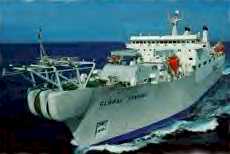Menu
Background: To really appreciate the value of this Technology a little background information is in order. To emphasize the importance of recent advances we'll talk about the particularly demanding usage of undersea cabling. Since the days of the Telegraph, cable has been an
Important part of Communications. It was necessary for the With the invention of the Radiotelephone (1927?) it at first seemed that laying cable, and it's uses would be obsolete. It soon became obvious that this new form of communications (radiotelephoning) had it's limitations and disadvantages. It could not be expanded because of a limited number of high-frequency bands. Because it travels through the air it is subject to atmospheric disturbances (which produce static) and it's signals tend to fade. There is also the issue of privacy, with radio signals "floating around" how can any level of privacy be assured? So, with that said, it looks like cable will be a permanent part of Communications Technology.
The first transatlantic telephone cable was
completed in 1956 as a joint effort between AT&T and British and Canadian
agencies. It was actually 2 cables at 20 miles apart, each carrying the voice in
1 direction. These cables were 2,250 miles long and ran from Newfoundland to
Scotland. To allow it to work over long distances amplifiers (repeaters) were
built into the cable to boost the signal at 40 mile intervals. The cost of this
project was $42 Million. These cables could carry 36 conversations simultaneously,
which was more than 2x the capacity of the Radiotelephone. After several
improvements in Copper Cabling and transistorized Repeaters, a 4,000
conversation cable was completed between the US and Britain in 1983. Fiber Optic cables, which use ultra-thin strands of glass to transmit pulses of highly focused Light (Laser) were introduced into service in 1977. By 1989 these cables could already carry 40,000 simultaneous conversations. Recent advances promise much higher data rates to come. Read about Alaska United, the first fiber optic cable system linking Alaska's major population centers to the lower 48 states. Follow their progress from start to finish across 2,331 miles. Special Thanks to: Alaska United, Fotec, CableU, and Fiber Options for their contributions and permissions to reference materials. |

 transmission of
telegraph signals across land and across water. As early as the 1850's cables
were being laid across the Atlantic Ocean. After several ill-fated attempts the
first successful transatlantic Telegraph cable was laid in 1866 connecting
Heart's Content, Newfoundland with Valentia, Ireland.
transmission of
telegraph signals across land and across water. As early as the 1850's cables
were being laid across the Atlantic Ocean. After several ill-fated attempts the
first successful transatlantic Telegraph cable was laid in 1866 connecting
Heart's Content, Newfoundland with Valentia, Ireland.  Telephone cable is similar to the telegraph cable. At it's
center is a Copper conductor which transmits the voice in 1 direction. Around
this core are various layers of material for insulation, (sea water, because of
it's high mineral content, is a particularly good conductor of Electricity!)
protection, (against rocks, ships, icebergs, fishing trawlers and undersea
creatures etc.) and the return conductor. The cabling used for deep-sea applications measures about 1.5 inches in diameter and weighs over 2.5 tons per
mile. Cable for shallow water, which needs more protection, is about 2.5
inches in diameter and weighs close to 24 tons/mile! The lifespan of the
cable is estimated at 30 - 40 yrs.
Telephone cable is similar to the telegraph cable. At it's
center is a Copper conductor which transmits the voice in 1 direction. Around
this core are various layers of material for insulation, (sea water, because of
it's high mineral content, is a particularly good conductor of Electricity!)
protection, (against rocks, ships, icebergs, fishing trawlers and undersea
creatures etc.) and the return conductor. The cabling used for deep-sea applications measures about 1.5 inches in diameter and weighs over 2.5 tons per
mile. Cable for shallow water, which needs more protection, is about 2.5
inches in diameter and weighs close to 24 tons/mile! The lifespan of the
cable is estimated at 30 - 40 yrs.